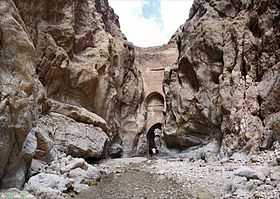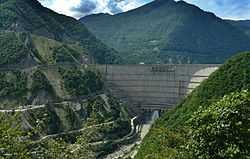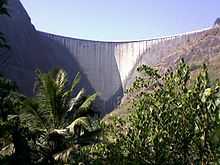Arch dam
An arch dam is a solid dam made of concrete that is curved upstream in plan.[1] The arch dam is designed so that the force of the water against it, known as hydrostatic pressure, presses against the arch, compressing and strengthening the structure as it pushes into its foundation or abutments. An arch dam is most suitable for narrow gorges or canyons with steep walls of stable rock to support the structure and stresses.[2] Since they are thinner than any other dam type, they require much less construction material, making them economical and practical in remote areas.
Classification
In general, arch dams are classified based on the ratio of the base thickness to the structural height (b/h) as:[1]
- thin, for b/h less than 0.2,
- medium-thick, for b/h between 0.2 and 0.3, and
- thick, for b/h ratio over 0.3.
Arch dams classified with respect to their structural height are:[1]
- Low dams up to 100 feet,
- Medium high dams between 100– 300 feet,
- High dams over 300 feet.
History

The development of arch dams throughout history began with the Romans in the 1st century BC and after several designs and techniques were developed, relative uniformity was achieved in the 20th century. The first known arch dam, the Glanum Dam, also known as the Vallon de Baume Dam, was built by the Romans in France and it dates back to the 1st century BC.[3][4][5] The dam was about 12m high and 18m in length. Its radius was about 14m and it consisted of two masonry walls. The Romans built it to supply nearby Glanum with water.
The Monte Novo Dam in Portugal was another early arch dam built by the Romans in 300 AD. It was 5.7m high and 52m long with a radius of 19m. The curved ends of the dam met with two winged walls that were later supported by two buttresses. The dam also contained two water outlets to drive mills downstream.[6]
The Dara Dam was another arch dam built by the Romans in which the historian Procopius would write of its design: "This barrier was not built in a straight line, but was bent into the shape of a crescent, so that the curve, by lying against the current of the river, might be able to offer still more resistance to the force of the stream."[3]
The Mongols also built arch dams in modern-day Iran. Their earliest was the Kebar Dam built around 1300, which was 26 m high and 55 m long, and had a radius of 35 m. Their second dam was built around 1350 and is called the Kurit Dam. After 4 m was added to the dam in 1850, it became 64 m tall and remained the tallest dam in the world until the early 20th century. The Kurit Dam was of masonry design and built in a very narrow canyon. The canyon was so narrow that its crest length is only 44% of its height. The dam is still erect, even though part of its lower downstream face fell off.[4]
The Elche Dam in Elche, Spain was a post-medieval arch dam built in the 1630s by Joanes del Temple and the first in Europe since the Romans. The dam was 26 m high and 75 m long, and had a radius of 62 m. This arch dam also rest on winged walls that served as abutments.[4]
In the 20th century, the world's first variable-radius arch dam was built on the Salmon Creek near Juneau, Alaska. The Salmon Creek Dam's upstream face bulged upstream, which relieved pressure on the stronger, curved lower arches near the abutments. The dam also had a larger toe, which off-set pressure on the upstream heel of the dam, which now curved more downstream. The technology and economical benefits of the Salmon Creek Dam allowed for larger and taller dam designs. The dam was, therefore, revolutionary, and similar designs were soon adopted around the world in particular by the U.S. Bureau of Reclamation.[4]

Arch dam designs would continue to test new limits and designs such as the double- and multiple-curve. The Swiss engineer Alfred Stucky and the U.S. Bureau of Reclamation would develop a method of weight and stress distribution in the 1960s, and arch dam construction in the United States would see its last surge then with dams like the 143-meter double-curved Morrow Point Dam in Colorado.[7] By the late 20th century, arch dam design reached a relative uniformity in design around the world.[4] Currently, the tallest and largest arch dam in the world is the 292 m Xiaowan Dam in China, which was completed in 2010.[4] The longest multiple arch with buttress dam in the world is the Daniel-Johnson Dam in Quebec, Canada. It is 214 meters high and 1,314 meters long across its crest. It was completed in 1968 and put in service in 1970.[8] In 2013 China completed an arch dam, Jinping 1 Dam, which is world's tallest at 305m.[9]
Design
The design of an arch dam is a very complex process. It starts with an initial dam layout, that is continually improved until the design objectives are achieved within the design criteria.[1][10]
Loads
The main loads for which an arch dam is designed are:[1][10]
- Dead Load
- Hydrostatic Load generated by the reservoir and the tailwater,
- Temperature Load
- Earthquake Load
Other miscellaneous loads that affect a dam include: ice and silt loads, and uplift pressure.[1] [10]

Most often, the arch dam is made of concrete and placed in a "V"-shaped valley. The foundation or abutments for an arch dam must be very stable and proportionate to the concrete. There are two basic designs for an arch dam: constant-radius dams, which have constant radius of curvature, and variable-radius dams, which have both upstream and downstream curves that systematically decrease in radius below the crest. A dam that is double-curved in both its horizontal and vertical planes may be called a dome dam. Arch dams with more than one contiguous arch or plane are described as multiple-arch dams. Early examples include the Roman Esparragalejo Dam with later examples such as the Daniel-Johnson Dam (1968) and Itaipu Dam (1982). However, as a result of the failure of the Gleno Dam shortly after it was constructed in 1923, the construction of new multiple arch dams has become less popular.[11]
Contraction joints are normally placed every 20 m in the arch dam and are later filled with grout after the control cools and cures.[12]
Examples of arch dams

- Buchanan Dam (example of Multiple-Arch type)
- Daniel-Johnson Dam
- Contra Dam
- El Atazar Dam
- Flaming Gorge Dam
- Glen Canyon Dam
- Idukki Dam
- Inguri Dam
- Karun-3 dam
- Pensacola Dam (longest Multiple-Arch type)
- Victoria Dam
- Mauvoisin Dam
- Luzzone Dam
- Xiluodu Dam
- Deriner Dam
See also
References
- ↑ 1.0 1.1 1.2 1.3 1.4 1.5 Design of Arch Dams - Design Manual for Concrete Arch Dams, Denver Colorado: Bureau of Reclamation, 1977
- ↑ "Arch Dam Forces". Archived from the original on 5 February 2007. Retrieved 2007-02-05.
- ↑ 3.0 3.1 Smith, Norman (1971), A History of Dams, London: Peter Davies, ISBN 0-432-15090-0
- ↑ 4.0 4.1 4.2 4.3 4.4 4.5 "Key Developments in the History of Arch Dams". Cracking Dams. SimScience. Retrieved 18 July 2010.
- ↑ D.Patrick JAMES, Hubert CHANSON. "Historical Development of Arch Dams. From Cut-Stone Arches to Modern Concrete Designs". Barrages.org. Retrieved 18 July 2010.
- ↑ Chaason, Hubert. "EXTREME RESERVOIR SEDIMENTATION IN AUSTRALIA: A REVIEW" (PDF). Resources Journal. p. 101. Retrieved 18 July 2010.
- ↑ "Arch Dam Design Concepts and Criteria". Durham University. Retrieved 18 July 2010.
- ↑ Guimont, Andréanne (3 August 2010). "Manic 5 : colossal témoin du génie québécois en hydroélectricité". suite101.fr. Archived from the original on 17 August 2010. Retrieved 30 September 2010.
- ↑ "The world's highest arch dam Jinping first production unit" (in Chinese). Economic Times Network. 2 September 2013. Retrieved 9 September 2013.
- ↑ 10.0 10.1 10.2 Arch Dam Design - Engineering Manual EM 1110-2-2201, Washington DC: U.S.Army Corps of Engineers, 1994
- ↑ Herzog, Max A. M. (1999). Practical Dam Analysis. London: Thomas Telford Publishing. pp. 115, 119–126. ISBN 3-8041-2070-9.
- ↑ "Contraction Joints". Arch Dams. Durham University. Retrieved 18 July 2010.
External links
| Wikimedia Commons has media related to Arch dams. |